
Semimostye is a beautiful place in the center of St. Petersburg, where, standing on one bridge, you can see six more bridges, or even see more.
Also, according to legend, Semimostye is a place of power and has the ability to fulfill the most cherished desires.
Semimostye is a unique panorama of St. Petersburg, attracting many tourists, photographers and artists.
The place that fulfills wishes is located at the intersection of two channels of the city - Kryukov and Griboyedov; where an ensemble of three bridges is located next to each other: Pikalov, Staro-Nikolsky and Krasnoarmeysky bridges. It is to these three bridges that you need to follow in order to see the Semimost and make a wish.
From each of these three bridges, depending on how you stand, you can see six more bridges; and you can see more than six bridges (9). From different angles, only 5 bridges can be seen, or even 4. Nevertheless, it is the number "seven" (semimostye), as many say and believe, that is magical.

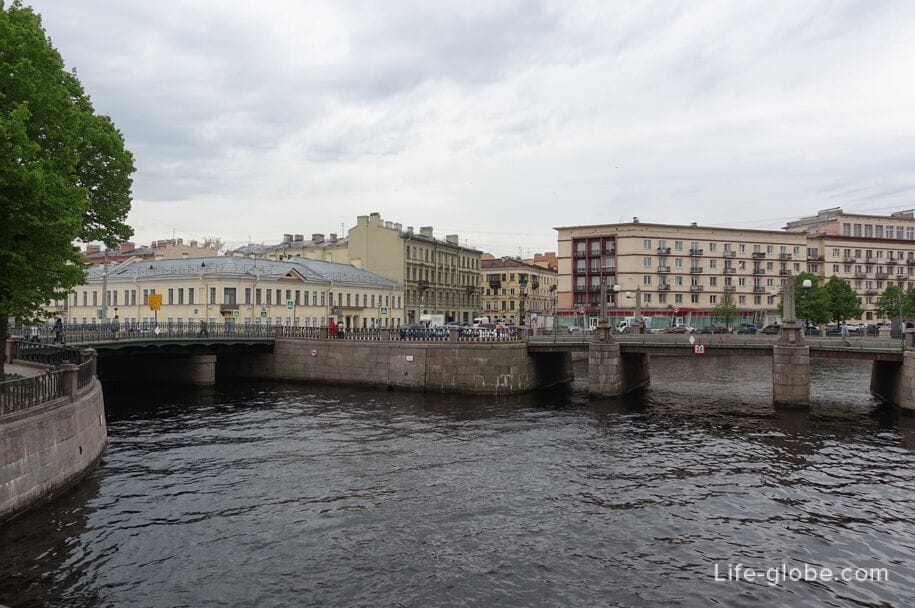
Names of bridges inSemimostye : Pikalov Bridge, Staro-Nikolsky Bridge, Krasnogvardeysky Bridge, Adjacent Bridge, Mogilevsky Bridge, Kashin Bridge and Novo-Nikolsky Bridge.
Perhaps Semimostye is the only place in St. Petersburg where, at the intersection of two channels, you can see what Peter the Great intended - a real "Northern Venice". That is why almost all river excursions along the rivers and canals of St. Petersburg, one way or another, take place under the Krasnogvardeysky Semimostya Bridge.
In order to fulfill wishes on Semimostye, there are various "rules" for making a wish correctly.
It is necessary to stand on the Pikalov Bridge, which is considered the central point of Semimostye, so that the bell tower of the St. Nicholas-Epiphany Naval Cathedral is on your left side, and the Krasnogvardeysky Bridge opens to your view; further behind the Krasnogvardeysky Bridge along the Griboyedov Canal will be located Novo-Nikolsky Bridge; to your right, where Sadovaya Street is the Staro-Nikolsky Bridge, behind it is an adjacent bridge; behind you will remain the Mogilev Bridge; and to the left along the Kryukov Canal - Kashin Bridge.
Standing on the Pikalov Bridge in this way and seeing the seven bridges, you can make a wish. They say that wishes come true!
Another version says that when making a wish, you need to turn around clockwise and see all seven bridges.
To enhance the magic of wish fulfillment, you need to make a wish on Semimostye at exactly 7 o'clock in the evening. And even better, on the 7th of any month, and even on July 7 at 19: 00 hours.
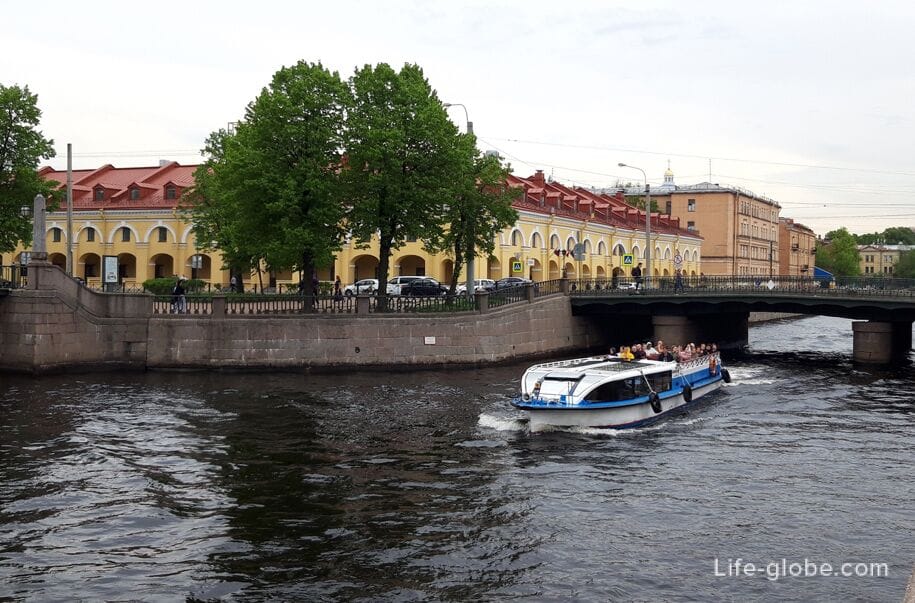
The Pikalov Bridge was built in 1783-1785 and named after the contractor who built it - Pikalov.
This bridge is the only crossing in this part of the city, which has generally preserved its historical appearance since the 1780s.
The bridge is located at the intersection of the Kryukov Canal with the Griboyedov Canal in its lower course. It connects Kolomensky and Pokrovsky Islands through the Griboyedov Canal in the Admiralteysky district of St. Petersburg.
The bridge is a three-span structure with a length of 24.5 meters and a width along the axes of the railing equal to 10.4 meters. The superstructure is reinforced concrete slab of a beam-split system, the facades are lined with a metal sheet.
The bridge is illuminated by 4 oval lamps of the "Washington" type, mounted on brackets. The floor lamps of the lanterns are granite obelisks located on intermediate supports.
The railing of the bridge is a light metal lattice of a simple pattern, on the postcards there are granite parapets.
The bridge is a roadway and pedestrian. The road surface is asphalt concrete, the sidewalks on the postcards are made of granite slabs.
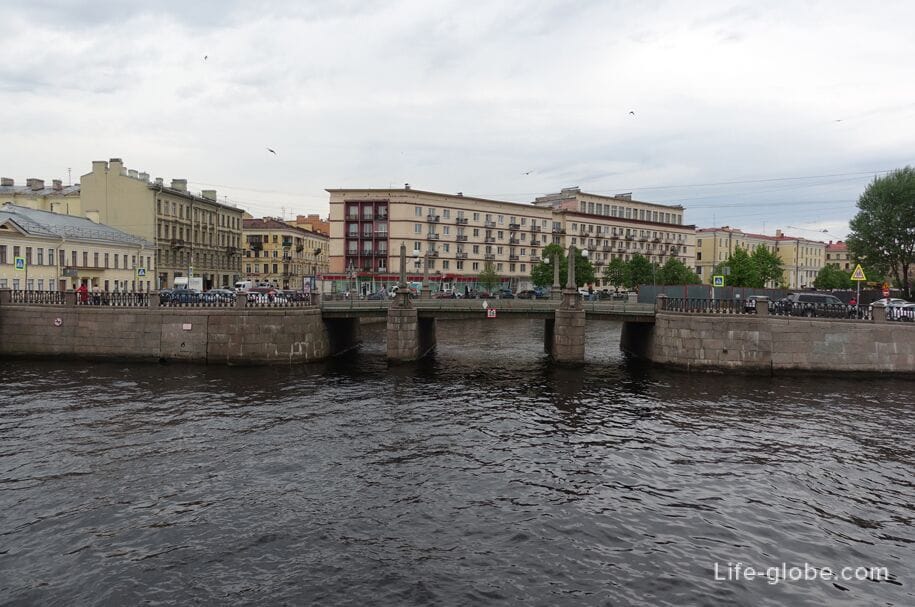
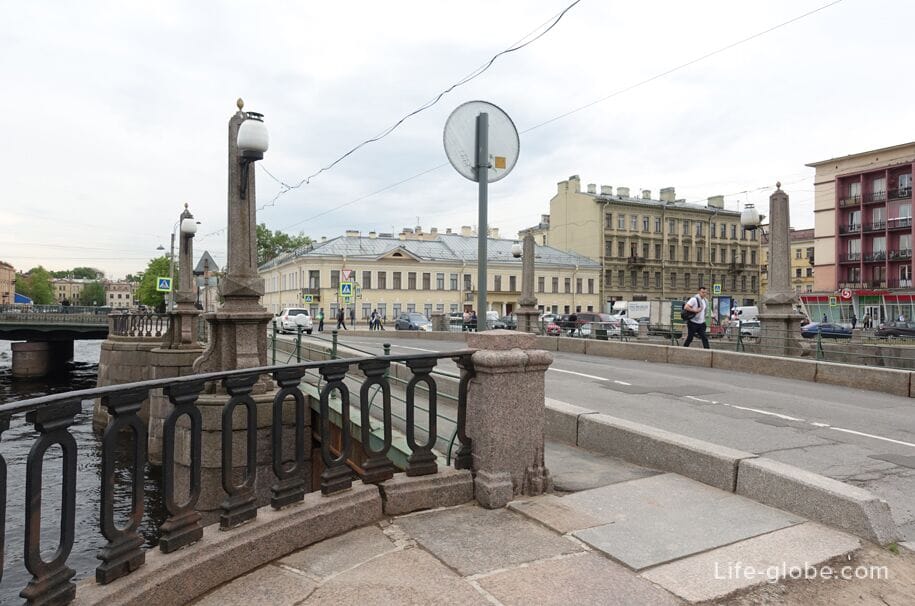
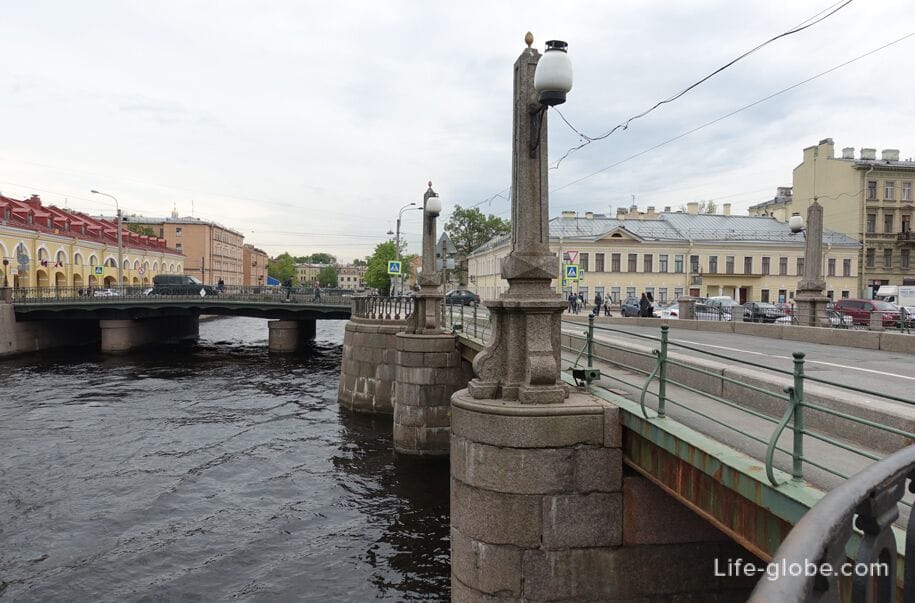
The Staro-Nikolsky Bridge was built in 1786 in the alignment of Sadovaya Street and named Nikolsky after the nearby Nikolsky Naval Cathedral.
During the history of the bridge, it was rebuilt and restored.
The bridge connects the Spassky and Pokrovsky islands. It is a three-span structure with a length of 31.6 meters and a width of 20.4 meters.
The superstructure of the metal beam-continuous system consists of 8 steel I-beams with a curved outline of the lower belt, united by transverse beams. In the middle span, the beams have a curved, concave outline from below to increase the navigable dimension. A reinforced concrete slab is arranged along the top of the beams. Abutments and river supports of rubble masonry with massive granite facing.
The bridge is designed for the movement of motor vehicles, trams and pedestrians.
The sidewalks are placed on consoles and separated from the roadway by a high granite parapet. The railing is metal, artistically forged with a complex pattern.
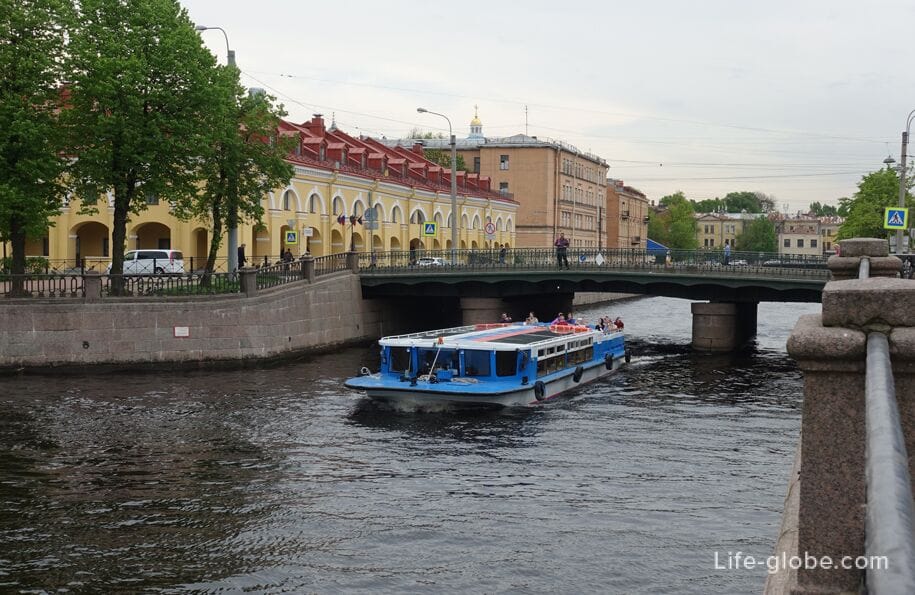
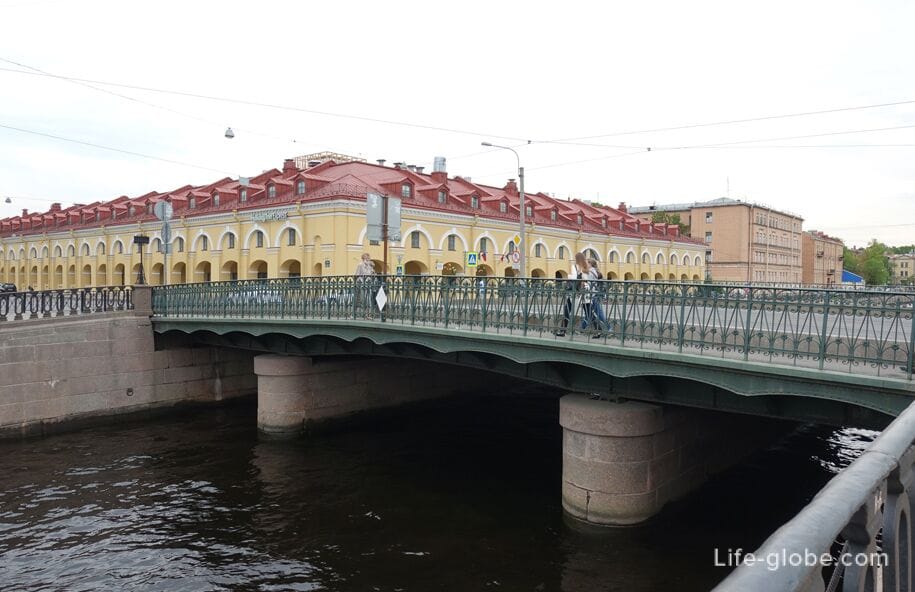
Next to the Staro-Nikolsky Bridge is the historical building of the Nikolsky market (Nikolsky Rows), built in 1787-1789 in the classical style. Read more about the Nikolsky Rows...
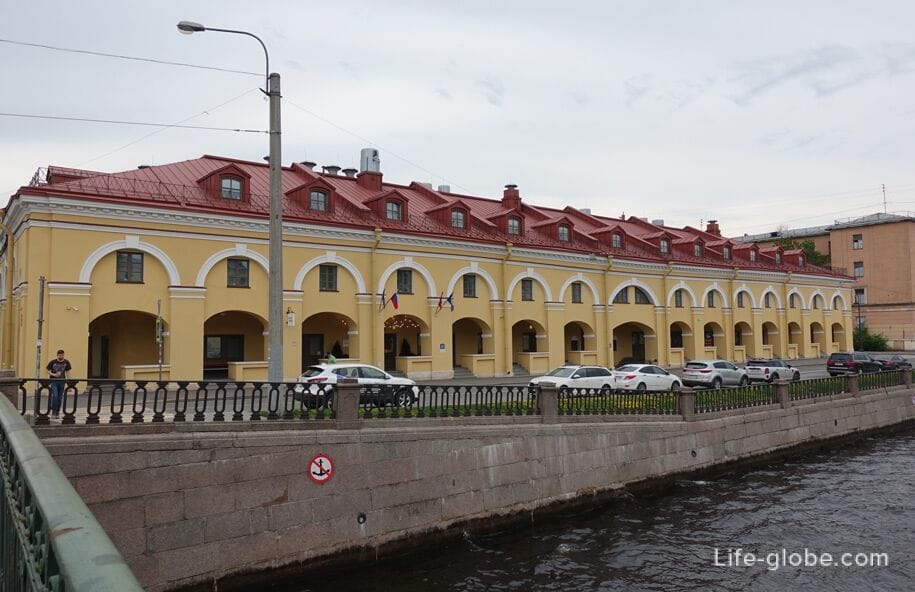
The first bridge on this site was built in 1957 due to the need to lay heating pipes, designed by engineer A. A. Kulikov, architects P. A. Areshev and V. S. Vasilkovsky.
The bridge received its name for the 40th anniversary of the Petrograd Red Guard, created in 1917.
This bridge is completely pedestrian, it is thrown over the Griboyedov Canal at its intersection with the Kryukov Canal. The bridge connects the Kazan and Spassky islands in the Admiralteysky district of the city.
The length of the bridge is 18.6 meters, and its width is 5 meters.
This is a single-span reinforced concrete bridge of a beam-split system. The abutments are reinforced concrete on pile bases, lined with granite and extended into the channel by 3.3 meters. The superstructure is a reinforced concrete frame. The surface is sandy asphalt.
The bridge is illuminated by hexagonal prismatic lanterns on four granite four-sided obelisks-floor lamps topped with cast-iron cones.
The railing of the bridge is metal, the pattern of the gratings resembles the fence of the Griboyedov Canal and the Fontank River.

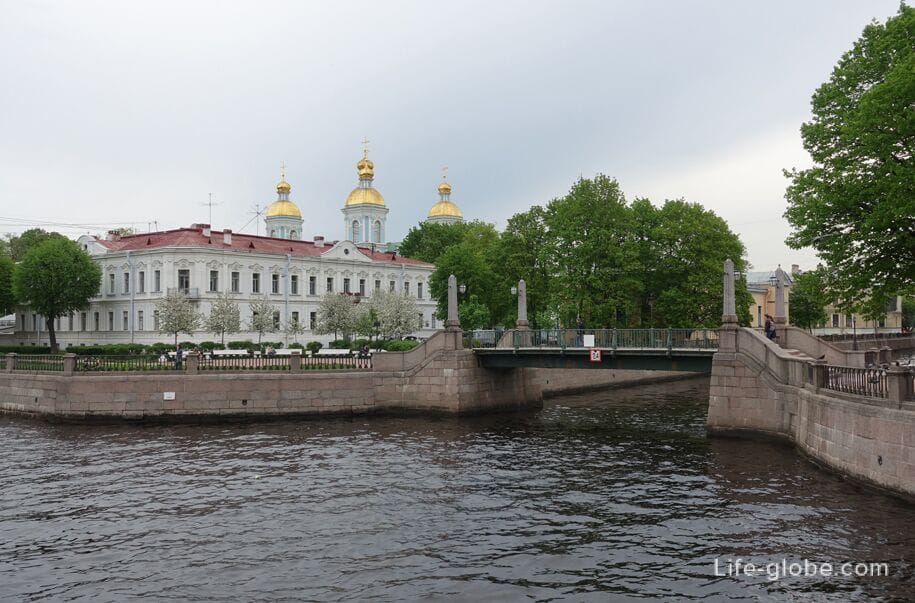
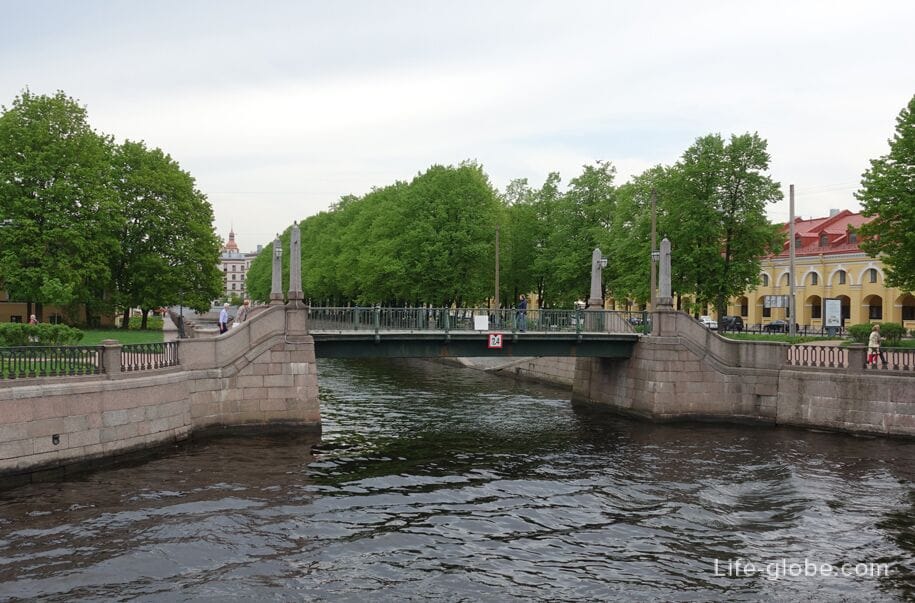
The entrances to the Krasnogvardeysky Bridge are made in the form of granite stairs with 7 steps and fences made of granite parapet.
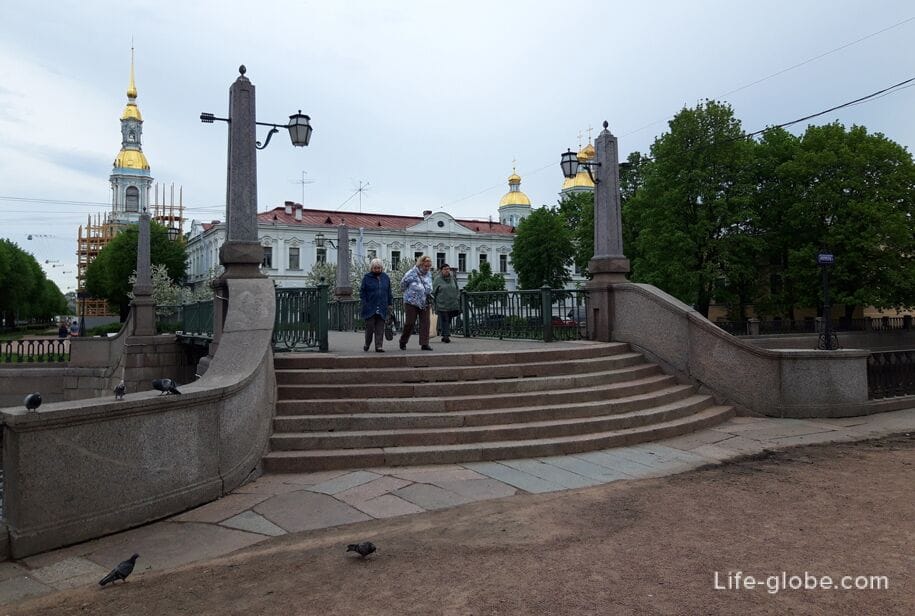
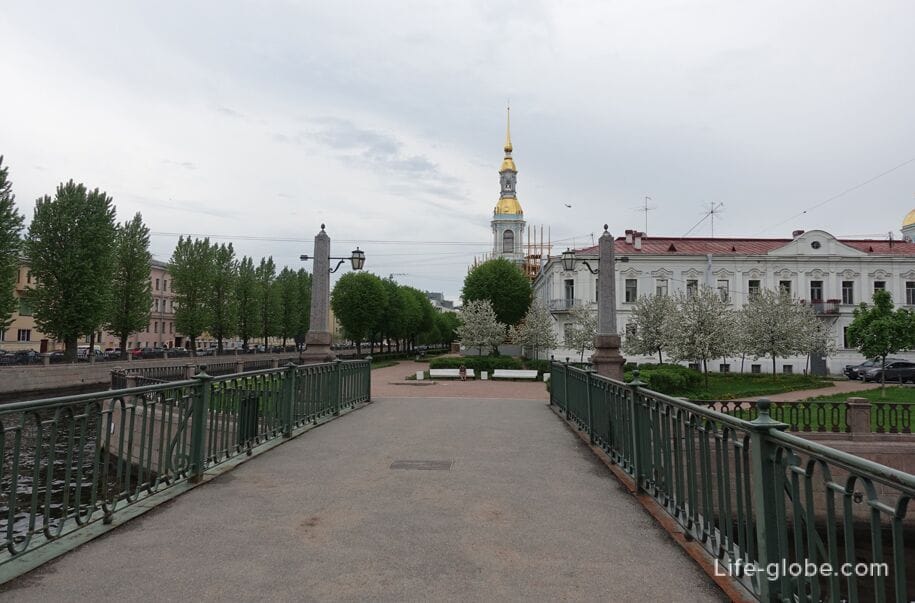
If you stand in the middle of the Krasnogvardeysky Bridge, then you can see nine different crossings spanning the canals at the same time along the circular panorama. The landscape is complemented by St. Nicholas Cathedral, the bell tower and the remote church of St. Isidore.
The first permanent wooden bridge in this place was built in 1783-1787 according to a standard project developed for the bridges of the Kryukov Canal.
The name "Adjacent" has been known since 1820 and is due to the fact that the ferry connects two parts of the Fontanka embankment.
During the history of the bridge, it was rebuilt and repaired.
The adjacent bridge spans the Kryukov Canal at its confluence with the Fontanka River.
This is a three-span metal bridge of a beam-split system. The bridge is 27 meters long and 15.3 meters wide.
The abutments and supports of the bridge are reinforced concrete on a pile base, lined with granite and are located in line with the wall of the Fontanka River embankment. The sidewalks are separated from the roadway by a high granite curb. For the transition from the sidewalks to the level of the embankments, staircases are arranged. The roadway is a reinforced concrete slab with an asphalt concrete coating.
The railing of the bridge is metal with a simple but unusual pattern in the form of two crossed anchors.



The bridge was built in 1911-1912 and had three spans.
In 1928, the middle span of the bridge was made movable and increased in width. During the siege of Leningrad, the crossing was completely destroyed. In 1951-1953, a new single-span reinforced concrete arch bridge was built according to the project of engineer V. V. Blazhevich and architect S. G. Krasikov.
The name "Mogilev" bridge received from the former name of the part of Lermontovsky Prospekt between the Griboyedov Canal and Fontanka, which until 1859 was called Dirty Street, then Mogilev, which, in turn, received this name from the Belarusian city of Mogilev. According to the custom that existed at that time, new names were given, mainly for provincial cities and large rivers.
The Mogilev Bridge spans the Griboyedov Canal along the axis of Lermontovsky Prospekt, and connects Kolomensky and Pokrovsky Islands.
The length of the bridge is 28.3 meters, and its width is 23.5 meters.
This is a single-span arch bridge. The superstructure is a reinforced concrete double-hinged arch, the facades are lined with pink granite with rusticated stone in the castle. The abutments are reinforced concrete, on a pile base, lined with granite. Granite parapets are installed on the abutments. The pavement on the bridge is asphalt concrete.
The railing of the bridge is cast-iron artistic casting on cast-iron bollards.
The bridge is illuminated by 4 hexagonal lamps on floor lamps.

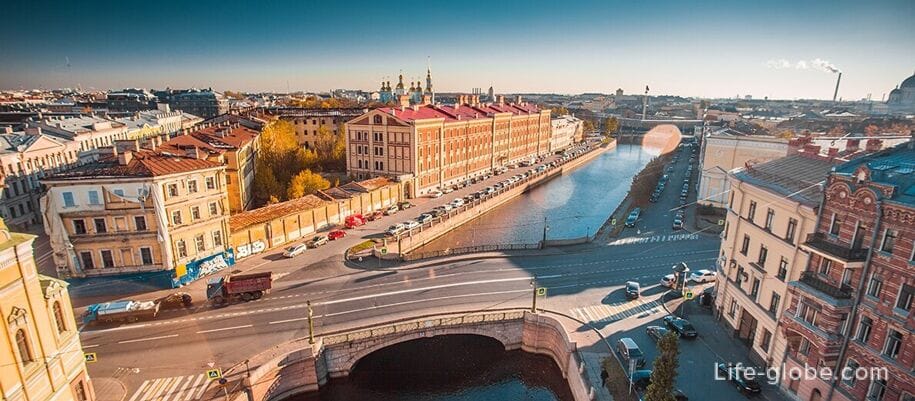
At the Mogilev Bridge on the right bank of the Griboyedov Canal there is a church in the name of St. Isidor Yuryevsky (St. Isidor's), formerly the church of the Estonian Orthodox Brotherhood, built in 1903-1907 by the architect A.A. Poleshchuk.
The bridge was built in 1782-1787 according to the standard design of the Kryukov Canal bridges. Initially, the bridge was given the name Nikolaevsky, in 1789 it was renamed Nikolsky-after the St. Nicholas Cathedral located nearby. Since 1795, the bridge was called Kashin, after the name of the owner of a nearby drinking house.
Kashin Bridge spans the Kryukov Canal along the axis of Rimsky-Korsakov Avenue and connects Kolomensky and Kazansky Islands.
The length of the bridge is 30.4 meters, the width is 16.3 meters.
This is a single-span arch bridge. The superstructure is a hinged arch, and by design - a simple reinforced concrete vault. The abutments are made of monolithic reinforced concrete on a pile base, lined with granite. The metal railings of a simple pattern, without curbstones, are completed on the abutments with granite parapets. For the transition from the sidewalks of the bridge to the level of the embankments, staircases are arranged.
Near the Kashin Bridge there is a historical building-the house of R. G. Vega, made in the neoclassical style. Learn more about the Vega house...

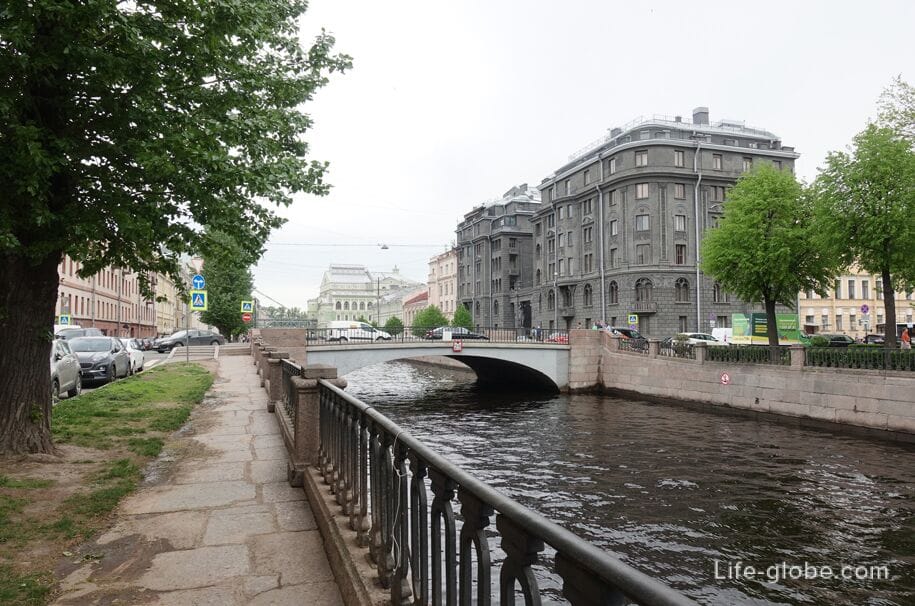


The first cast-iron Novo-Nikolsky Bridge over the Catherine Canal (now the Griboyedov Canal) was built in 1835-1837 according to the project of engineers I. S. Zavadovsky and M. E. Clark.
On October 8, 1837, just before the opening, the bridge collapsed. M.E. Clark was commissioned to design a more reliable Novo-Nikolsky Bridge. The construction was carried out under the supervision of engineer E.A. Adam and architect K.I. Rossi.
Finally, in 1841, a new steel girder bridge was opened on stone abutments lined with granite, which became the first crossing of such a structure across the Catherine Canal.
In the future, the bridge was rebuilt and repaired.
The Novo-Nikolsky Bridge connects the Spassky and Kazan Islands in the Admiralteysky district. It is thrown over the Griboyedov Canal in the alignment of Nikolskaya Square and Nikolsky Lane.
The bridge itself is very modest; it is devoid of any frills and decorations. But, despite this, it is inscribed in history - in Dostoevsky, for example, the bridge is mentioned in the story "White Nights".
The bridge is a single-span arched structure with a length of 22.8 meters and a width of 22.6 meters. The superstructure is a solid reinforced concrete arch, the abutments are massive stone on a pile base, lined with granite.
The railings of the bridge are metal, and their pattern resembles the pattern of the grid of the embankment of the Obvodny Canal. Granite slabs are placed on the sidewalks of the bridge openings, staircases are arranged for the transition from the sidewalks to the embankments.
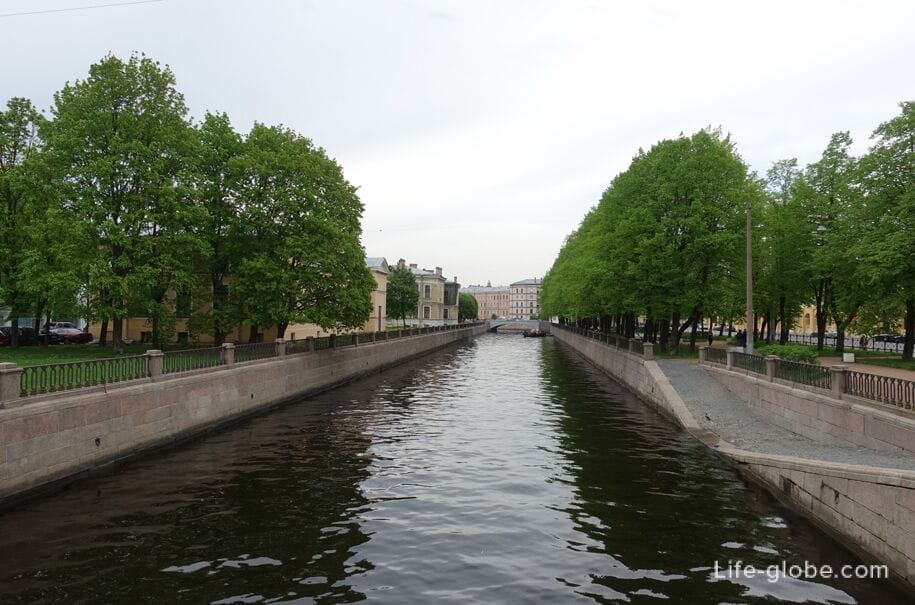
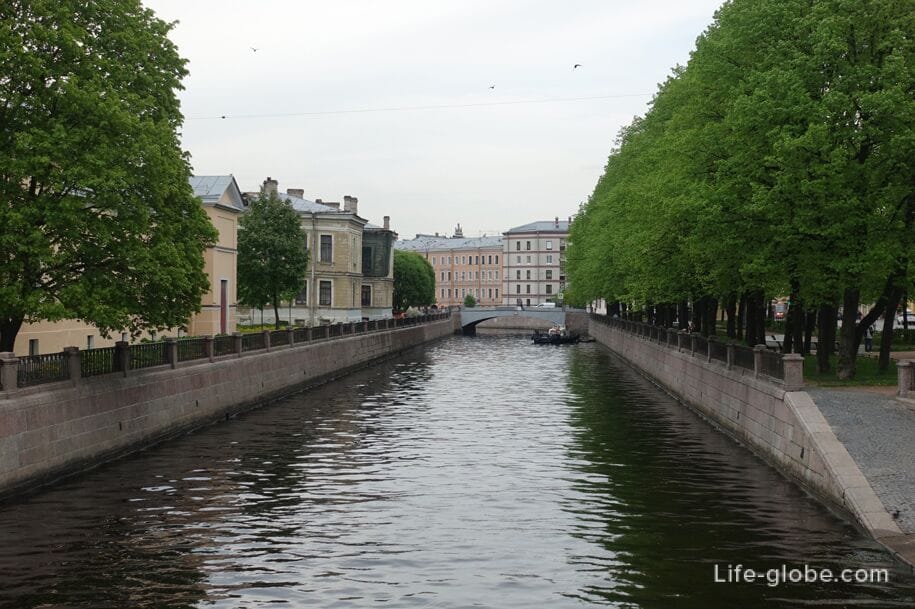
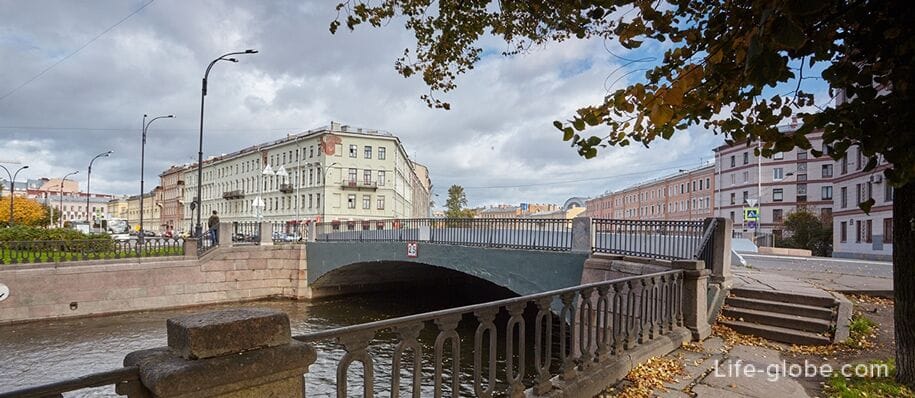
In addition to Semimostya, in Saint Petersburg there is a unique Three Bridge, which consists of a bridge composition that includes three bridges: Teatralny, Malo-Konyushenny and False (Land bridge-dam). Read more about Three-Bridge...
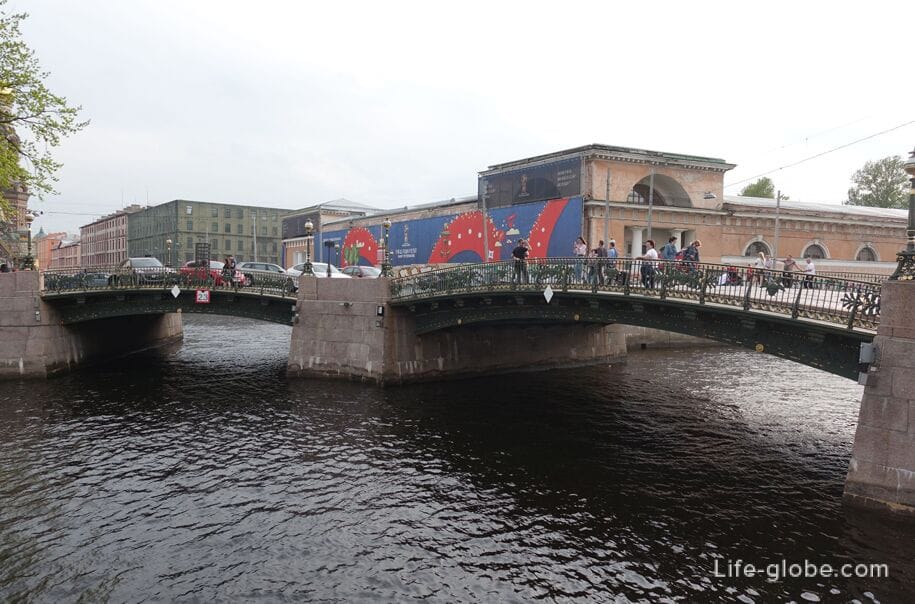
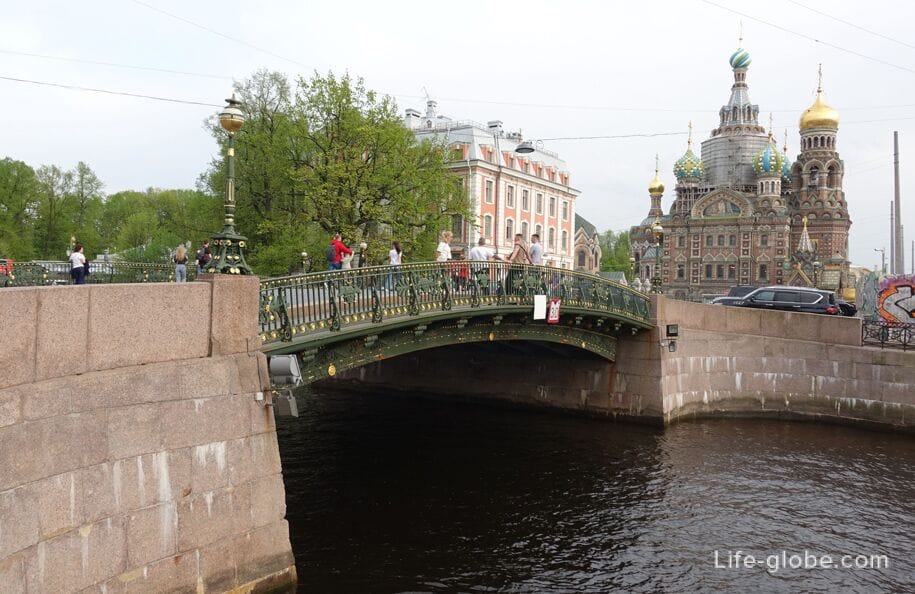
Coordinates of the "main" Semimostya - Pikalov bridge: 59°55'15.0"N 30°17'54.0"E (59.920833, 30.298333).
Nearest metro stations: "Sadovaya", "Sennaya Ploshchad", "Spasskaya" and "Technological Institute".
All accommodation facilities in St. Petersburg, including in the city center, near Semimostya and more remotely from those, can be viewed and booked here